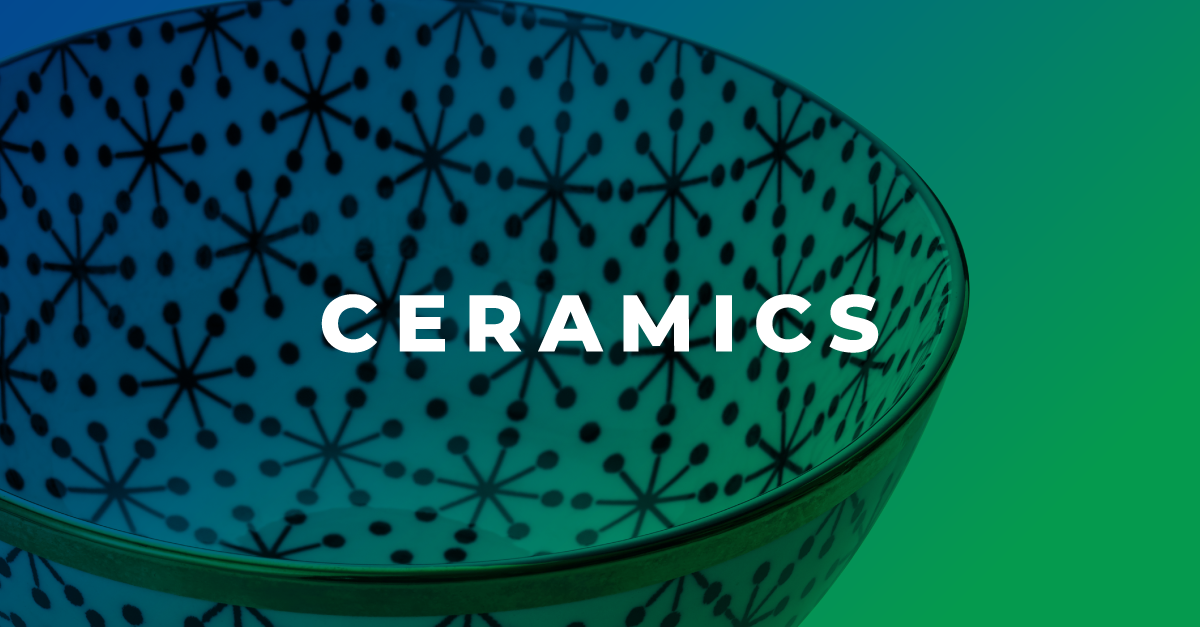
As part of our ASL One World initiative, we are aiming to identify and discuss issues related to environmental & social sustainability. Last week, in our first article of our blog series about materials, we considered aluminium, its properties, production and sustainability. This week we discuss ceramics.
Ceramics
A ceramic is an inorganic non-metallic solid made up of either metal or non-metal compounds that have been shaped and then hardened by heating to high temperatures. In general, they are hard, corrosion-resistant and brittle. 'Ceramic' comes from the Greek word meaning ‘pottery’. The clay-based domestic wares, art objects and building products are familiar to us all, but pottery is just one part of the ceramic world.
This category of materials includes things like tile, bricks, plates, glass, and toilets. They can be found in products like watches (quartz tuning forks-the time keeping devices in watches), snow skies (piezoelectric-ceramics that stress when a voltage is applied to them), automobiles (sparkplugs and ceramic engine parts found in race cars), and phone lines. They can also be found on space shuttles, appliances (enamel coatings), and airplanes (nose cones).
Ceramics are generally made by taking mixtures of clay, earthen elements, powders, and water and shaping them into desired forms. Once the ceramic has been shaped, it is fired in a high temperature oven known as a kiln. Often, ceramics are covered in decorative, waterproof, paint-like substances known as glazes. Nowadays the term ‘ceramic’ has a more expansive meaning and includes materials like glass, advanced ceramics and some cement systems as well.
How are ceramics produced?
Ceramics generally start with a clay-based material dug from the ground that's mixed with water (to make it soft and flexible) and other materials, squashed into shape, then fired at high-temperature in a large industrial oven called a kiln. Firing is what most ceramics have in common. These four basic processes — digging the raw material from the ground, adding water, shaping, and firing — have been used to make ceramics for thousands of years.
There are six types of clay: common clay, kaolin (China clay), bentonite, ball clay, fuller's Earth, and fire clay, and each has a number of different uses. Each one of these also has numerous different grades and qualities, so it's probably more accurate to talk about China clays or Ball clays in the plural. Before they're fired, raw ceramics can be shaped in all kinds of ways; different manufacturing processes are used for different end products. While a great deal of modern pottery is moulded, some is still thrown by hand, on a foot-powered wheel, in the traditional way. Other ceramic processes include pressing (squeezing powder into a mould), casting, and jiggering (laying raw material into a rotating mould). Advanced engineering ceramics are often made in more advanced ways. For example, the silicon nitride used in cutting tools is made by reaction bonding, in which silicon powder is squashed into shape and heated with nitrogen gas.
Despite the energy needed to fire a kiln, if the heat is well managed and distributed, and if no toxic materials are added to the clay or in the finish, then ceramic can be considered eco-friendly.
Properties of ceramics
As we've already seen, the most important general property of ceramics is that they're refractory: they're rough-and-tumble materials that will put up with fair amounts of abuse in the most ordinary and extraordinary situations. Just consider, most of us tile our kitchens and bathrooms because ceramic tiles are hard, waterproof, largely resistant to scratches, and keep on looking good for year upon year; but engineers also put (very different!) ceramic tiles on space rockets to protect them against heat when they whiz back to Earth.
Ceramics have:
- High melting points (so they're heat resistant).
- Great hardness & strength.
- Considerable durability (they're long-lasting and hard-wearing).
- Low electrical & thermal conductivity (they're good insulators).
- Chemical inertness (they're unreactive with other chemicals).
Most ceramics are also nonmagnetic materials, although ferrites (iron-based ceramics) happen to make great magnets, because of their iron content. The traditional ceramics like glass or porcelain, have one major drawback: they can be fragile and brittle, and they'll smash or shatter if you drop them (subject them to "mechanical shock") or suddenly change their temperature ("thermal shock").
To summarize the main properties of ceramics are:
- hard,
- wear-resistant,
- brittle,
- refractory,
- thermal insulators,
- electrical insulators,
- nonmagnetic,
- oxidation resistant,
- prone to thermal shock, and
10. chemically stable.
| Property | Uses | Examples |
| Hard & Strong | Building materials |
Tiles, bricks, roofs, cement |
| Attractive, easily moulded & glazed | Decorative pieces & household items | Vases, porcelain-ware, sinks, baths |
| Chemically inert & non-corrosive | Kitchenware | Cooking pots, plates & bowls |
| Very high melting point and good insulator of heat | Insulation | Furnace lining, engine parts |
| Electrical Insulators | Insulating parts in electrical appliances | Spark plugs, insulators in ovens & electrical cables |
| Inert & non-compressible | Medical & dental apparatus | Artificial teeth & bones |
Advantages & Disadvantage
As with every material there are advantages and disadvantages when using ceramics:
| Advantages | Disadvantages |
| Reusable | Dimensional tolerances difficult to control during processing |
| Lower carbon footprint over their life span | Weak in tension |
| Biodegradable | Poor shock resistance |
| Harder than conventional structure metals | Can crack when hit with heavy items |
| Low co-efficiency of friction | Cannot be recycled (only upcycled/downcycled) |
| Extremely high melting point | High carbon footprint in manufacturing |
| Corrosion resistance | Takes up more space in transportation |
| Low density | Requires more packaging |
| Extreme hardness | Heavier than some materials |
| Glazed ceramic does not stain | Some coatings lead to a significant increase in the time needed to biodegradable |
| When it breaks down, leaves no toxic ingredients behind | Costly |
Alternatives
Let’s take a look at a few materials that are sometimes used instead of ceramics:
- Aluminium or steel (steel is heavier hence a relatively bigger transport footprint)
- Glass
- Coffee
- Sugarcane
- Bamboo (depending on its manufacturing process)
- Palm leaf (usually not reusable)
- Wood from FSC resources (depending on the thickness of the items)
- Rice husks (outer layers that protect grains of rice)
Summary
In conclusion, ceramic is a relatively sustainable material with a wide variety of applications. Its stability and durability make it an excellent choice for a wide range of products in many different environments. One drawback is it's relatively high cost as opposed to some alternative materials, but the ability to re-use ceramic products, enabling a longer useful lifespan, can help to offset this additional expenditure.
Are you looking for innovative, sustainable marketing services support? Contact us to discover how ASL can help your marketing campaigns become more environmentally sustainable and socially responsible.

Discover more about our ONE WORLD initiative







